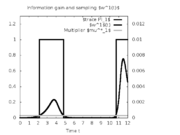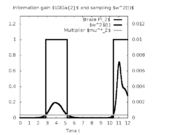Difference between revisions of "Lotka Experimental Design"
m (plots uploaded) |
FelixMueller (Talk | contribs) |
||
| (6 intermediate revisions by 3 users not shown) | |||
| Line 1: | Line 1: | ||
{{Dimensions | {{Dimensions | ||
|nd = 1 | |nd = 1 | ||
| − | |nx = | + | |nx = 11 |
|nw = 2 | |nw = 2 | ||
| − | |nre = | + | |nc = 4 |
| + | |nre = 11 | ||
}} | }} | ||
| Line 36: | Line 37: | ||
\quad \dot{G_{21}}(t) & = & f_{x21}(\cdot) \; G_{11}(t) + f_{x22}(\cdot) \; G_{21}(t), \\ | \quad \dot{G_{21}}(t) & = & f_{x21}(\cdot) \; G_{11}(t) + f_{x22}(\cdot) \; G_{21}(t), \\ | ||
\quad \dot{G_{22}}(t) & = & f_{x21}(\cdot) \; G_{12}(t) + f_{x22}(\cdot) \; G_{22}(t) + f_{p24}(\cdot), \\ | \quad \dot{G_{22}}(t) & = & f_{x21}(\cdot) \; G_{12}(t) + f_{x22}(\cdot) \; G_{22}(t) + f_{p24}(\cdot), \\ | ||
| − | \quad \dot{F_{11}}(t) & = & w^1(t) G_{11}(t)^2 + w^2(t) G_{ | + | \quad \dot{F_{11}}(t) & = & w^1(t) G_{11}(t)^2 + w^2(t) G_{21}(t)^2, \\ |
| − | \quad \dot{F_{12}}(t) & = & w^1(t) G_{11}(t) G_{12}(t) + w^2(t) G_{ | + | \quad \dot{F_{12}}(t) & = & w^1(t) G_{11}(t) G_{12}(t) + w^2(t) G_{21}(t) G_{22}(t), \\ |
| − | \quad \dot{F_{22}}(t) & = & w^1(t) G_{ | + | \quad \dot{F_{22}}(t) & = & w^1(t) G_{12}(t)^2 + w^2(t) G_{22}(t)^2, \\ |
\quad \dot{z^1}(t) & = & w^1(t), \\ | \quad \dot{z^1}(t) & = & w^1(t), \\ | ||
\quad \dot{z^2}(t) & = & w^2(t), \\[1.5ex] | \quad \dot{z^2}(t) & = & w^2(t), \\[1.5ex] | ||
| Line 80: | Line 81: | ||
* [[:Category:AMPL | AMPL]] at [[Lotka Experimental Design (AMPL)]] | * [[:Category:AMPL | AMPL]] at [[Lotka Experimental Design (AMPL)]] | ||
| + | * [[:Category: VPLAN | VPLAN code]] at [[Lotka Experimental Design (VPLAN)]] | ||
== Variants == | == Variants == | ||
| Line 85: | Line 87: | ||
There are several alternative formulations and variants of the above problem, in particular | There are several alternative formulations and variants of the above problem, in particular | ||
| − | * a prescribed time grid for the control function < | + | * a prescribed time grid for the control function <bib id="Sager2006" />, see also [[Lotka Experimental Design (AMPL)]], |
* no fishing, i.e., <math>u \equiv 0</math>, | * no fishing, i.e., <math>u \equiv 0</math>, | ||
* different fishing control functions for the two species, | * different fishing control functions for the two species, | ||
| Line 91: | Line 93: | ||
== Miscellaneous and Further Reading == | == Miscellaneous and Further Reading == | ||
| − | The Lotka Volterra fishing problem was introduced by Sebastian Sager in a proceedings paper < | + | The Lotka Volterra fishing problem was introduced by Sebastian Sager in a proceedings paper <bib id="Sager2006" /> and revisited in his PhD thesis <bib id="Sager2005" />. These are also the references to look for more details. The experimental design problem has been described in the habilitation thesis of Sager, <bib id="Sager2011d" />. |
== References == | == References == | ||
| − | < | + | <biblist /> |
<!--List of all categories this page is part of. List characterization of solution behavior, model properties, ore presence of implementation details (e.g., AMPL for AMPL model) here --> | <!--List of all categories this page is part of. List characterization of solution behavior, model properties, ore presence of implementation details (e.g., AMPL for AMPL model) here --> | ||
Latest revision as of 10:31, 27 July 2016
| Lotka Experimental Design | |
|---|---|
| State dimension: | 1 |
| Differential states: | 11 |
| Discrete control functions: | 2 |
| Path constraints: | 4 |
| Interior point equalities: | 11 |
The Lotka Experimental Design problem looks for an optimal fishing strategy to be performed on a fixed time horizon to control the biomasses of both predator as prey fish as described in Lotka Volterra fishing problem. The goal here, however, is to minimize the uncertainty of a follow-up parameter estimation problem. In addition to the fishing decision the question when measurements of the two state variables are performed becomes a degree of freedom.
The mathematical equations form a small-scale ODE model. The ODE from Lotka Volterra fishing problem is extended such that it also includes state sensitivities, the Fisher information matrix entries and integrated sampling states.
The optimal integer control functions shows bang bang behavior.
Contents
[hide]Mathematical formulation
We are interested in estimating the parameters  and
and  of the Lotka-Volterra type predator-prey fish initial value problem
of the Lotka-Volterra type predator-prey fish initial value problem
![\begin{array}{rcl}
\dot{x_1}(t) &=& p_1 \; x_1(t) - p_2 x_1(t) x_2(t) - p_5 u(t) x_1(t), \; t \in [0,t_f], \quad x_1(0) = 0.5, \\
\dot{x_2}(t) &=& - p_3 \; x_2(t) + p_4 x_1(t) x_2(t) - p_6 u(t) x_2(t), \; t \in [0,t_f], \quad x_2(0) = 0.7,
\end{array}](https://mintoc.de/images/math/3/1/d/31daaad30b442898b092905f1c6b6f93.png)
where  is a fishing control that may or may not be fixed. The other parameters, the initial values and
is a fishing control that may or may not be fixed. The other parameters, the initial values and  are fixed. We are interested in how to fish and when to measure, with an upper bound
are fixed. We are interested in how to fish and when to measure, with an upper bound  on the measuring time. We can measure the states directly,
on the measuring time. We can measure the states directly,  and
and  . We use two different sampling functions,
. We use two different sampling functions,  and
and  in the same experimental setting. This can be seen either as a two-dimensional measurement function
in the same experimental setting. This can be seen either as a two-dimensional measurement function  , or as a special case of a multiple experiment, in which
, or as a special case of a multiple experiment, in which  , and
, and  are identical. The experimental design problem then reads
are identical. The experimental design problem then reads
![\begin{array}{lll}
\displaystyle \min_{x,G,F,z^1,z^2,u,w^1,w^2} && \text{trace} \; \left( F^{-1}(t_f) \right) \\
\text{subject to} \\
\quad \dot{x_1}(t) & = & p_1 \; x_1(t) - p_2 x_1(t) x_2(t) - p_5 u(t) x_1(t),\\
\quad \dot{x_2}(t) & = & - p_3 \; x_2(t) + p_4 x_1(t) x_2(t) - p_6 u(t) x_2(t),\\
\quad \dot{G_{11}}(t) & = & f_{x11}(\cdot) \; G_{11}(t) + f_{x12}(\cdot) \; G_{21}(t) + f_{p12}(\cdot), \\
\quad \dot{G_{12}}(t) & = & f_{x11}(\cdot) \; G_{12}(t) + f_{x12}(\cdot) \; G_{22}(t), \\
\quad \dot{G_{21}}(t) & = & f_{x21}(\cdot) \; G_{11}(t) + f_{x22}(\cdot) \; G_{21}(t), \\
\quad \dot{G_{22}}(t) & = & f_{x21}(\cdot) \; G_{12}(t) + f_{x22}(\cdot) \; G_{22}(t) + f_{p24}(\cdot), \\
\quad \dot{F_{11}}(t) & = & w^1(t) G_{11}(t)^2 + w^2(t) G_{21}(t)^2, \\
\quad \dot{F_{12}}(t) & = & w^1(t) G_{11}(t) G_{12}(t) + w^2(t) G_{21}(t) G_{22}(t), \\
\quad \dot{F_{22}}(t) & = & w^1(t) G_{12}(t)^2 + w^2(t) G_{22}(t)^2, \\
\quad \dot{z^1}(t) & = & w^1(t), \\
\quad \dot{z^2}(t) & = & w^2(t), \\[1.5ex]
\quad x(0) &=& (0.5, 0.7), \\
\quad G(0) &=& F(0) = 0, \\
\quad z^1(0) &=& z^2(0) = 0, \\ [1.5ex]
\quad u(t) & \in & \mathcal{U}, \; w^1(t) \in \mathcal{W}, \; w^2(t) \in \mathcal{W}, \\
\quad 0 & \le & M - z(t_f)
\end{array}](https://mintoc.de/images/math/b/e/5/be5084191cfd38542a980de5e92ba3b7.png)
with
 ,
,
 ,
,
 ,
,
 , and
, and
 ,
,
 .
.
Note that the state  has been left out for reasons of symmetry.
has been left out for reasons of symmetry.
Parameters
We use  ,
,  , and
, and  ,
,  . The upper bound on the measurement time intervals is chosen as
. The upper bound on the measurement time intervals is chosen as  .
.
Reference Solutions
Here is one local solution to the above control problem.
- Reference solution plots
Source Code
Model descriptions are available in
Variants
There are several alternative formulations and variants of the above problem, in particular
- a prescribed time grid for the control function [Sager2006]Address: Heidelberg
Author: S. Sager; H.G. Bock; M. Diehl; G. Reinelt; J.P. Schl\"oder
Booktitle: Recent Advances in Optimization
Editor: A. Seeger
Note: ISBN 978-3-5402-8257-0
Pages: 269--289
Publisher: Springer
Series: Lectures Notes in Economics and Mathematical Systems
Title: Numerical methods for optimal control with binary control functions applied to a Lotka-Volterra type fishing problem
Volume: 563
Year: 2009 , see also Lotka Experimental Design (AMPL),
, see also Lotka Experimental Design (AMPL), - no fishing, i.e.,
 ,
, - different fishing control functions for the two species,
- different parameters and start values.
Miscellaneous and Further Reading
The Lotka Volterra fishing problem was introduced by Sebastian Sager in a proceedings paper [Sager2006]Address: Heidelberg
Author: S. Sager; H.G. Bock; M. Diehl; G. Reinelt; J.P. Schl\"oder
Booktitle: Recent Advances in Optimization
Editor: A. Seeger
Note: ISBN 978-3-5402-8257-0
Pages: 269--289
Publisher: Springer
Series: Lectures Notes in Economics and Mathematical Systems
Title: Numerical methods for optimal control with binary control functions applied to a Lotka-Volterra type fishing problem
Volume: 563
Year: 2009 and revisited in his PhD thesis [Sager2005]Address: Tönning, Lübeck, Marburg
and revisited in his PhD thesis [Sager2005]Address: Tönning, Lübeck, Marburg
Author: S. Sager
Editor: ISBN 3-89959-416-9
Publisher: Der andere Verlag
Title: Numerical methods for mixed--integer optimal control problems
Url: http://mathopt.de/PUBLICATIONS/Sager2005.pdf
Year: 2005 . These are also the references to look for more details. The experimental design problem has been described in the habilitation thesis of Sager, [Sager2011d]Author: S. Sager
. These are also the references to look for more details. The experimental design problem has been described in the habilitation thesis of Sager, [Sager2011d]Author: S. Sager
How published: University of Heidelberg
Month: August
Note: Habilitation
Title: On the Integration of Optimization Approaches for Mixed-Integer Nonlinear Optimal Control
Url: http://mathopt.de/PUBLICATIONS/Sager2011d.pdf
Year: 2011 .
.
References
There were no citations found in the article.



